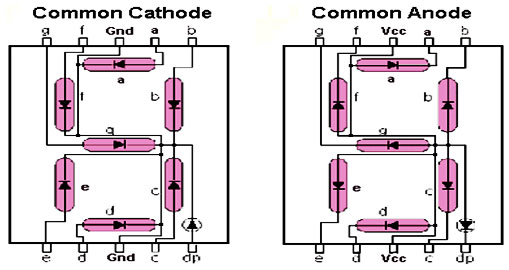

The lookup table is nothing but an array which has all the above values. Once you have all the values to be written to the display you have to create the lookup table.

The data to be displayed has to be framed separately for common cathode and common anode type displays In any kind of application, it’s good practice to have a Look-up-Table for the data to be displayed on the 7 segment. So we have to have a pre determined set of bitmaps for the numbers that we would be using. The data (bitmap) has to be sent to the 7 segment display from the controller through the data bus. If you are running too fast, it’s a waste of processor time which prevents any other useful work from happening. This way you will be able to use all the 4 digits to do some useful work.
Write data to be displayed to Segment 1 into the data latch. To use all the 4 displays to display 4 different data at the same time, you should follow this sequence. Logic to use all the 4 digits of the display Here is the video from that post, just in case you are too lazy to follow the link. You can check that out if you have any uncertainties. In an older article, have already discussed persistence of vision at lengths. Our microcontroller instructions are operated in a few hundred nanoseconds, toggling a pin or a set of pins at 50 or 60 Hertz is no big deal. So if you turn ON and OFF a light faster than that, you won’t be able to notice the light going OFF. This time is directly proportional to the brightness of the light signal. Put it numerically, your eye will hold the light signal for a little over one quarter of a second. The human eye has the ability to hold a memory of light signal for some time after they are gone. That is when we will exploit the disability (well not exactly) of the human eye. If that were the case, then the whole point of having a 4 digit display would be lost. Ie., If you latch something to the data bus, and enable all the pins,(send it a logic HIGH from the MCU) then the same data will be displayed on all the four segments. So far it appears as though, only one segment can be used at time as the data lines are shared with all the 4 segments. This connection has a common data bus for all the segments and has a separate enable line for each segment that is used to turn ON and turn OFF that particular segment. Though it is not impossible, you will have a difficult time making out what-is-what without part names. If you desoldered it from somewhere, hope you have some marking over it. They look alike and there is no way to tell which one you have by just seeing it. Yes, there are two types of 7 segment displays. If you are using a development board, you should read it’s documentation before addressing them. While addressing these segments, (in most cases) A is the LSB and DP(H) is the MSB. These 8 pins corresponding to each of the segments are connected to the port pins of a microcontroller. These segments are named with alphabets A through G with a DP (Decimal Point) or in some cases an eighth alphabet H. These are essentially LEDs that turn on according to the excitation given by the controller that gives the appearance of the number. As the name suggests, there are 7 segments to display a number and an additional decimal point. #7 segment common anode how to
This post will deal with the basics of 7 segment displays and how to interface them with microcontrollers.






 0 kommentar(er)
0 kommentar(er)
